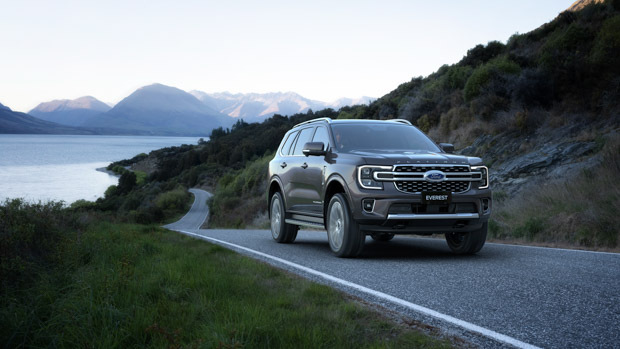-
Car Reviews
- Car News
-
Car Comparisons
Latest comparisons
- Chasing Deals
Learn every feature of the new Ford Everest large SUV in one convenient place
Ford has today unveiled the third-generation Everest four-wheel-drive wagon that is bound for the Australian market in the second half of the year.
Based on the same platform as the new-generation Ranger, the Everest has seen several significant improvements including the introduction of a turbo-diesel V6 engine, a full-time four-wheel-drive system as well as safety and technology upgrades.
To cover the new-generation Everest in detail we have written three articles focusing on Ford’s 4WD wagon and provided a walkaround video where editor Tom Baker offered his first impressions.
Learn more about the 2023 Ford Everest here:
Ford unveiled the new-generation Everest this week that will go into production in May 2022, meaning it will likely arrive on our shores between late July and early August.
The 2022 Everest has replaced the Titanium grade with a new Platinum grade that pitches the 4WD upmarket at rivals such as the Toyota Prado Kakadu.
Designers have also modernised the interior with a 12.3-inch digital display in front of the driver and a huge 12.0-inch portrait touchscreen on the higher grades.
Safety has also seen a boost with nine airbags found throughout the cabin including a front-centre airbag as well as active safety equipment such as rear AEB and adaptive cruise control.
However, the biggest change can be found under the bonnet where Ford has crammed a 3.0-litre turbo-diesel V6 engine that will likely produce 190kW of power and 600Nm of torque.
It will be offered alongside the existing 157kW/500Nm 2.0-litre twin-turbo-diesel four-cylinder engine which has been strengthened for the new generation.
Both engines will be matched with a 10-speed automatic transmission and a full-time four-wheel-drive system.
A significant redesign of the suspension system and the addition of newer and upgraded engines have seen the Everest’s towing capacity increase to 3500kg.
That headline figures matches newer rivals like the Isuzu MU-X and even the Toyota Land Cruiser 300 Series, and surpass key rivals such as the Toyota Prado (3000kg) and Toyota Fortuner (3100kg).
The headline figure only applies if buyers opt for the optional tow pack that also adds an integrated trailer brake controller and trailer light-check function.
Latest news
About Chasing cars
Chasing Cars reviews are 100% independent.
Because we are powered by Budget Direct Insurance, we don’t receive advertising or sales revenue from car manufacturers.
We’re truly independent – giving you Australia’s best car reviews.

